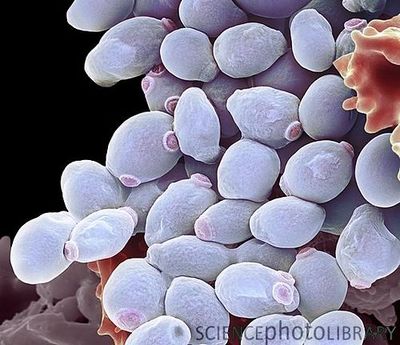Candida albicans (Pathogenesis)


Etiology/Bacteriology
Taxonomy
| Domain = Eukaryota | Phylum = Ascomycota | Class = Saccharomycetes | Order = Saccharomycetales | Family = Saccharomycetaceae | Genus = Candida | species = albicans
|
NCBI: Taxonomy Genome: Candida albicans |
Description
Candida albicans is an opportunistic fungal pathogen that is responsible for candidiasis in human hosts. C. albicans grow in several different morphological forms, ranging from unicellular budding yeast to true hyphae with parallel-side wall (4). Typically, C. albicanslive as harmless commensals in the gastrointestinal and genitourinary tract and are found in over 70% of the population. Overgrowth of these organisms, however, will lead to disease, and it usually occurs in immunocompromised individuals, such as HIV-infected victims, transplant recipients, chemotherapy patients, and low birth-weight babies (3). There are three major forms of disease: oropharyngeal candidiasis, vulvovaginal candidiasis, and invasive candidiasis. Over 75% of women will suffer from a C. albicans infection, usually vulvovaginal candidiasis, in their lifetimes, and 40-50% of them will have additional occurrences(s). Interestingly, C. albicans are the 4th leading cause for nosocomial infections in patients’ bloodstreams. This could result in an extremely life-threatening, systemic infection in hospital patients with a mortality rate of 30% (2). For oropharyngeal candidiasis, infection occurs in the mouth or throat, and is identified by white plaque growth on oral mucous membranes. Vulvovaginal candidiasis or a “yeast infection” is the overgrowth of C. albicans in the vagina, and results in rash, itchiness, and discharge from the genital region. Lastly, invasive candidiasis occurs when the fungal pathogen enters the bloodstream and can easily spread to organs throughout the body. Invasive candidiasis is best identified when antibiotics fail to cure a patient’s fever (5). C. albicans infections are usually treatable with fluconazole, while severe infections require amphotericin B.
Pathogenesis
Transmission
Fleas
Fluid/Tissue
Infectious Droplets
Infectious dose, incubation, colonization
Epidemiology
United States
Worldwide
Virulence factors
Adhesion/invasion
Nutrient acquisition
Type III secretion system
Yop effectors
Anti-phagocytic antigens
Clinical features
Symptoms
Bubonic Plague
Septicemic Plague
Pneumonic Plague
Morbidity and Mortality
Diagnosis
Treatment
Antibiotics
Prophylaxis
Prevention
Host Immune Response
Attack on Innate Immune Response
Attack on Adaptive Immune Response
Host Immune Response
References
Created by Johnson Ong, a student of Tyrrell Conway at the University of Oklahoma.
